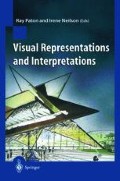Abstract
Representations used in science may be separated into two classes: atomistic representations, which model discrete entities interacting through pair-wise forces, and continuous representations, which model derived properties that vary continuously through space. The choice of an atomistic or a continuous model is governed primarily by the complexity of the system: atomistic models are useful in systems with several thousand interacting entities, whereas continuous models are necessary in larger systems. In molecular biology, atomistic models are used at two levels: at the atomic level, where the atomic structure of molecules is studied, and at the molecular level, where the molecular structure of cells is studied. Continuous models are also useful at both levels, for simplifying the atomic details of large, complex molecules, and for simplifying the molecular details of entire cells.
Access this chapter
Tax calculation will be finalised at checkout
Purchases are for personal use only
Preview
Unable to display preview. Download preview PDF.
References
Goodsell DS and Olson AJ. Soluble proteins: size, shape and function. Trends Biochem. Sci. 1993; 18:65–68.
Richardson JS. The anatomy and taxonomy of protein structure. Adv. Protein Chem. 1981; 34:167–339.
Lee B and Richards FM. The interpretation of protein structures: estimation of static accessibility. J. Mol. Biol. 1971; 55:379–400.
Fulton AB. How crowded is the cytoplasm? Cell 1982; 30:345–347.
Zimmerman SB and Minton AP. Macromolecular crowding: biochemical, biophysical, and physiological consequences. Annu. Rev. Biophys. Biocool. Struct. 1993; 22:27–65.
Minton AP. Macromolecular crowding and molecular recognition. J. Mol. Recognition 1993; 6:211–214.
Guttman HJ, Anderson CF and Record MT. Analysis of thermodynamic data 155 for concentrated hemoglobin solutions using scaled particle theory: implications for a simple two-state model of water in thermodynamic analyses of crowding in vitro and in vivo. Biophys. J. 1995; 68:835–846.
Blattner FR, Plunkett G, Bloch CA, et al. The complete genome sequence of Escherichia coli K-12. Science 1997; 277:1453–1462.
VanBogelen RA, Sankar P, Clark RL, Bogan JA and Neidhardt FC. The gene-protein database of Escherichia coli: edition 5. Electrophoresis 1992; 13:1014–1054.
Goodsell DS. Inside a living cell. Trends in Biochem. Sci. 1991; 16(6):203–206.
Author information
Authors and Affiliations
Editor information
Editors and Affiliations
Rights and permissions
Copyright information
© 1999 Springer-Verlag London
About this paper
Cite this paper
Goodsell, D.S. (1999). Atomistic vs. Continuous Representations in Molecular Biology. In: Paton, R., Neilson, I. (eds) Visual Representations and Interpretations. Springer, London. https://doi.org/10.1007/978-1-4471-0563-3_15
Download citation
DOI: https://doi.org/10.1007/978-1-4471-0563-3_15
Publisher Name: Springer, London
Print ISBN: 978-1-85233-082-8
Online ISBN: 978-1-4471-0563-3
eBook Packages: Springer Book Archive

